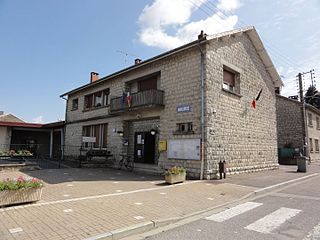
On 10 June 1944, four days after D-Day, the village of Oradour-sur-Glane in Haute-Vienne in Nazi-occupied France was destroyed when 643 civilians, including non-combatant men, women, and children, were massacred by a German Waffen-SS company as collective punishment for Resistance activity in the area including the capture and subsequent execution of a close friend of Waffen-SS Sturmbannführer Adolf Diekmann, Sturmbannführer Helmut Kämpfe, who an informant incorrectly claimed had been burned alive in front of an audience. Kämpfe was a commander in the 2nd SS Panzer Division Das Reich.

The Malmedy massacre was a German war crime committed by soldiers of the Waffen-SS on 17 December 1944 at the Baugnez crossroads near the city of Malmedy, Belgium, during the Battle of the Bulge. Soldiers of Kampfgruppe Peiper summarily killed eighty-four U.S. Army prisoners of war (POWs) who had surrendered after a brief battle. The Waffen-SS soldiers had grouped the U.S. POWs in a farmer's field, where they used machine guns to shoot and kill the grouped POWs; many of the prisoners of war who survived the gunfire of the massacre were killed with a coup de grâce gunshot to the head. A few survived.

The Yvette is a small river in southern Île-de-France (France), left tributary of the Orge, which is a tributary of the Seine. It is 39.3 km (24.4 mi) long. Its source is in Les Essarts-le-Roi, north of Rambouillet, in the Yvelines department. Various communes of the Essonne département are named after it: Bures-sur-Yvette, Gif-sur-Yvette and Villebon-sur-Yvette.

The 3rd Infantry Division was an infantry division of the German Army that fought in World War II. The division was established under the cover name Wehrgauleitung Frankfurt in 1934 by expanding the 3rd Division of the Reichswehr. It was redesignated Kommandant von Frankfurt shortly afterward, and took on its bona fide name when the formation of the Wehrmacht was announced in October 1935. In March 1939 the division took part in the invasion and occupation of Czechoslovakia.

The arrondissement of Bar-le-Duc is an arrondissement of France in the Meuse department in the Grand Est region. It has 110 communes. Its population is 59,980 (2016), and its area is 1,450.7 km2 (560.1 sq mi).

The Saulx is a 115 km long river in France, right tributary of the Marne. Its source is near the village Germisay. It flows generally northwest, through the following départements and towns:

Beurey-sur-Saulx is a commune in the Meuse department in the Grand Est region in northeastern France.

Le Bouchon-sur-Saulx is a commune in the Meuse department in Grand Est in northeastern France.

Mognéville is a commune in the Meuse department in Grand Est in north-eastern France.

Robert-Espagne is a commune in the Meuse department in Grand Est in north-eastern France.

Oradour-sur-Glane is a commune in the Haute-Vienne department, Nouvelle-Aquitaine, west central France, as well as the name of the main village within the commune.

The Battle of Dinant was an engagement fought by French and German forces in and around the Belgian town of Dinant in the First World War, during the German invasion of Belgium. The French Fifth Army and the British Expeditionary Force (BEF) advanced into Belgium and fought the Battle of Charleroi (21–23 August) and Battle of Mons (23 August), from the Meuse crossings in the east, to Mons in the west. On 15 August 1914, German troops captured the Citadel of Dinant which overlooked the town; the citadel was recaptured by a French counter-attack during the afternoon.
The canton of Ligny-en-Barrois is an administrative division of the Meuse department, northeastern France. Its borders were modified at the French canton reorganisation which came into effect in March 2015. Its seat is in Ligny-en-Barrois.
The canton of Revigny-sur-Ornain is an administrative division of the Meuse department, northeastern France. Its borders were modified at the French canton reorganisation which came into effect in March 2015. Its seat is in Revigny-sur-Ornain.
Lucie Bouniol was a French sculptor and painter from the department of Tarn in southern France, who exhibited widely throughout the 20th century.
Communauté d'agglomération de Bar-le-Duc - Sud Meuse is the communauté d'agglomération, an intercommunal structure, centred on the town of Bar-le-Duc. It is located in the Meuse department, in the Grand Est region, northeastern France. Created in 2013, its seat is in Bar-le-Duc. Its area is 400.0 km2. Its population was 34,222 in 2019, of which 14,625 in Bar-le-Duc proper.

The Sack of Dinant or Dinant massacre refers to the mass execution of civilians, looting and sacking of Dinant, Neffe and Bouvignes-sur-Meuse in Belgium, perpetrated by German troops during the Battle of Dinant against the French in World War I. Convinced that the civilian population was hiding francs-tireurs, the German General Staff issued orders to execute the population and set fire to their houses.

The canton of Bar-le-Duc-Sud is a former French canton located in the department of Meuse in the Lorraine region. It is now part of the canton of Bar-le-Duc-1 and canton of Bar-le-Duc-2.

The canton of Montiers-sur-Saulx is a former French canton located in the department of Meuse in the Lorraine region. This canton was organized around Montiers-sur-Saulx in the arrondissement of Bar-le-Duc. It is now part of the canton of Ligny-en-Barrois.


















